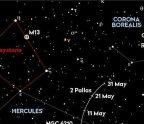URBAN STARGAZING Astronomy under light-polluted skies

While the world of astronomy regularly trades on visions of dark expanses swarming with stars and the river-like Milky Way arcing over remote landscapes, the reality for most of us is that stargazing occurs under, or close to, the bright lights of towns and cities. From these locations contemplating the Universe can be challenging, as wasted artificial light fills the sky with a diffuse, nocturnal glow.
Although the near-fantastical vistas of Instagram and space documentaries might be lightyears from our ‘every night’ experience, there’s still an enormous diversity of engaging targets for an astronomer to enjoy under urban and suburban night skies. In this article we highlight a few key examples – and offer some tips on how to get started – to show that you don’t need to live under the darkest skies to connect with the wonders of the cosmos above.

Will Gater is an astronomy journalist and science presenter. His book, The Mysteries of the Universe, is published by DK

Getting transparent about light pollution
A key factor that influences how bad the effects of light pollution are is the haziness of the sky
If you live in an urban or suburban area, the fact that
You’re reading a preview, subscribe to read more.
Start your free 30 days





